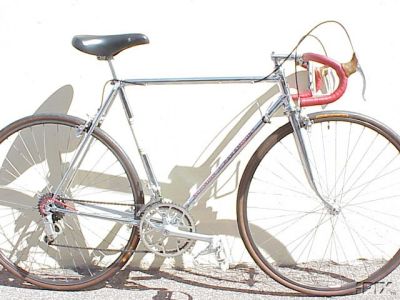Does anybody out there know what is the historical origin of the 72 to 74 degree seat tube angle used on most modern road (not tri) bikes? I believe I understand the reason for the head tube angle and how it has gotten a bit steeper (now towards 74-75 deg.) over the years due to the general improvement in roads which has reduced the need for highly raked forks which has in turn reduced the need for a lot of 'fork trail' which has reduced the need for highly slack head tube angles (but correct me if I am wrong in any of this).
Other than the aesthetic desire to have the seat tube approximately match the angle of the head tube, I have not read or heard of any other explanation for the choice of 72 to 74 deg. SEAT TUBE angle. Do you know of any? Since the American bike craze of the 1890s, has someone studied and quantified the effect of the seat tube angle on the human body or on frame design enough to have made this angle selection for the entire bike industry? Because if one looks at photos of American "safety bicycles" from the late 1890s, is interesting to note how head tube angles are quite slack, and that they are typically matched by a very similiar and very slack seat tube angle. Sometimes these "slack-angled" bikes from the 1890s have a very interesting seatpost: one that has a FORWARD elbow bend that then clamps the seat rails well forward of the end of the seat post, like some tri seatposts of today (perhaps to keep the rider's knee over the pedal spindle when the cranks are 3 and 9 o'clock with such a slack seat tube?). I have read biomechanical studies on the relationship between seat tube angle (and hip angle) and human power output, but all the studies that I have seen have been recent (within the last 25 years or so). But obviously frame makers were deciding on seat tube angles on "safety bicycles" well before that. What guided their choice?
If anybody knows where I can find out more about this, please let me know...
Other than the aesthetic desire to have the seat tube approximately match the angle of the head tube, I have not read or heard of any other explanation for the choice of 72 to 74 deg. SEAT TUBE angle. Do you know of any? Since the American bike craze of the 1890s, has someone studied and quantified the effect of the seat tube angle on the human body or on frame design enough to have made this angle selection for the entire bike industry? Because if one looks at photos of American "safety bicycles" from the late 1890s, is interesting to note how head tube angles are quite slack, and that they are typically matched by a very similiar and very slack seat tube angle. Sometimes these "slack-angled" bikes from the 1890s have a very interesting seatpost: one that has a FORWARD elbow bend that then clamps the seat rails well forward of the end of the seat post, like some tri seatposts of today (perhaps to keep the rider's knee over the pedal spindle when the cranks are 3 and 9 o'clock with such a slack seat tube?). I have read biomechanical studies on the relationship between seat tube angle (and hip angle) and human power output, but all the studies that I have seen have been recent (within the last 25 years or so). But obviously frame makers were deciding on seat tube angles on "safety bicycles" well before that. What guided their choice?
If anybody knows where I can find out more about this, please let me know...
